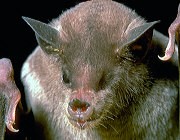Lesser long-nosed bat
| Lesser long-nosed bat | |
|---|---|
 |
|
| Lesser long-nosed bat | |
| Scientific classification | |
| Kingdom: | Animalia |
| Phylum: | Chordata |
| Class: | Mammalia |
| Order: | Chiroptera |
| Family: | Phyllostomidae |
| Genus: | Leptonycteris |
| Species: | L. yerbabuenae |
| Binomial name | |
|
Leptonycteris yerbabuenae Martinez & Villa, 1940 |
|
| Synonyms | |
|
L. nivalis yerbabuenae |
|
L. nivalis yerbabuenae
L. curasoae yerbabuenae
L. sanborni, Hoffmeister, 1957
The lesser long-nosed bat (Leptonycteris yerbabuenae) is a medium-sized bat found in Central and North America. It is sometimes known as Sanborn's long-nosed bat or the Mexican long-nosed bat, though the latter name is better avoided since it is also used for the entire genus Leptonycteris and for one of the other species in it, the greater long-nosed bat (L. nivalis).
Originally described as a subspecies of the greater long-nosed bat, it was later considered a subspecies of the southern long-nosed bat, before being confirmed as a distinct species. Enthusiasts for the bats often refer to them simply as leptos because they are the best known members of the genus Leptonycteris. The scientific name is derived from the type locality, near Yerbabuena in Guerrero, Mexico.
Lesser long-nosed bats are relatively small bats, with a total length as adults of around 8 centimetres (3.1 in), and weighing between 15 and 25 grams (0.53 and 0.88 oz), depending on the time of year. Males and females are similar in size, and virtually indistinguishable. As their common name implies, they have a long, narrow snout, and this terminates in a small triangular nose-leaf. While they do have three internal caudal vertebrae, they have no visible tail.
The tongue of lesser long-nosed bats has a number of adaptations for lapping nectar, including long ridges and rough, conical , which may also help protect against periodontal disease by scraping the teeth clean. Their wings have a high wing loading, allowing for energy efficient long-distance flight in open habitats, at the expense of manoeuvrability.
Only three other species of North American bat have a nose-leaf, and two of these, the Mexican long-tongued bat, and the California leaf-nosed bat, have a distinct tail, and also, in the latter case, much larger ears than lesser long-nosed bats do. They are more easily confused with their close relatives, the greater long-nosed bats, but, in addition to being about 10% larger, the latter have shorter, greyish fur, and proportionately longer wings.
...
Wikipedia

